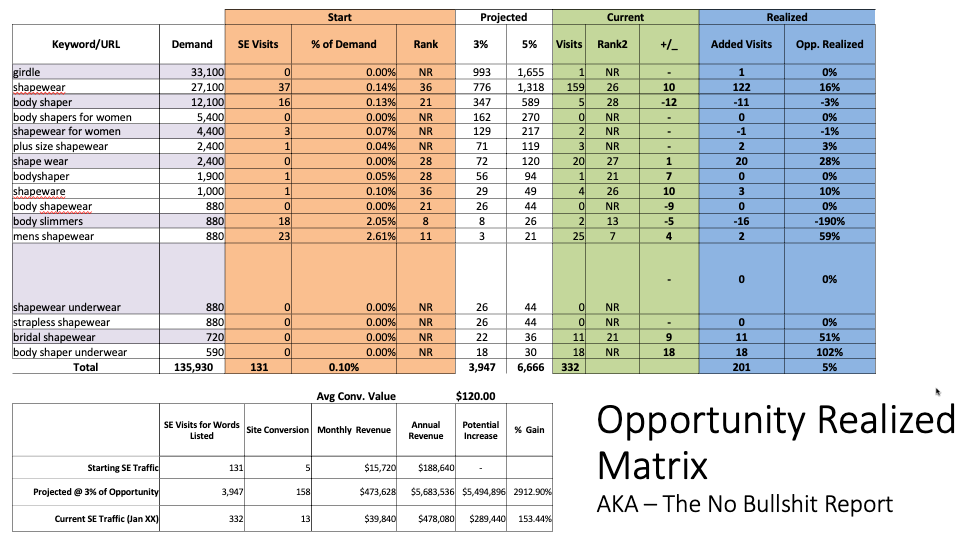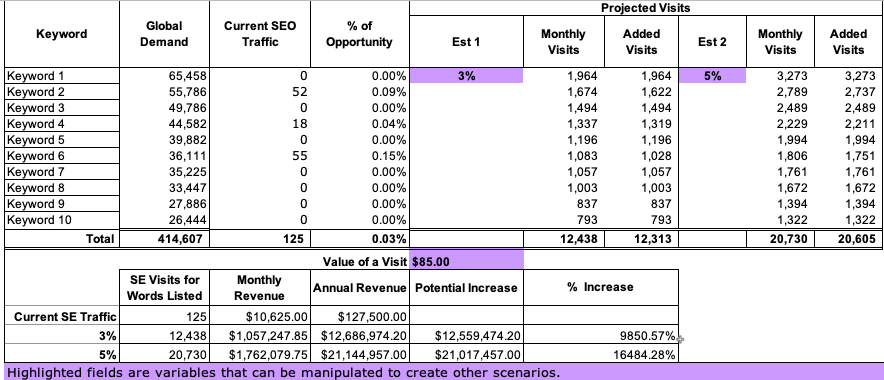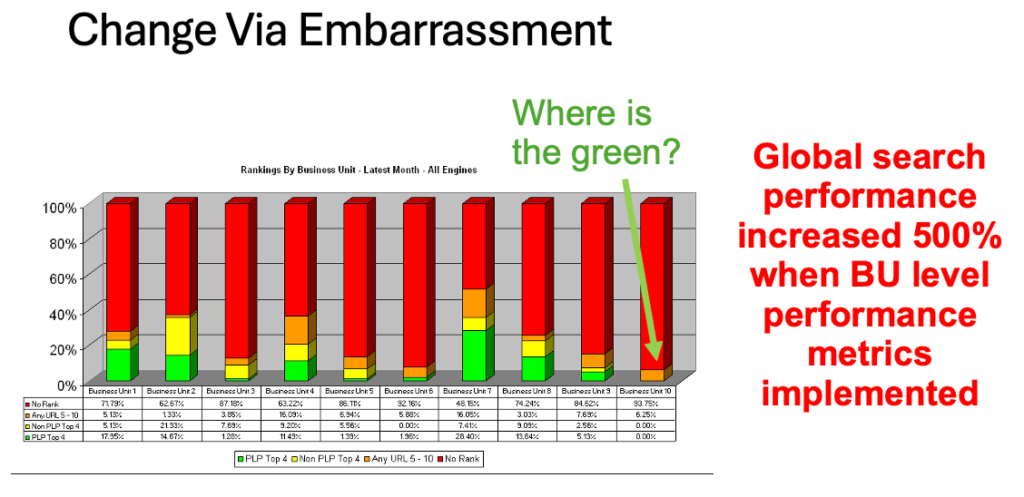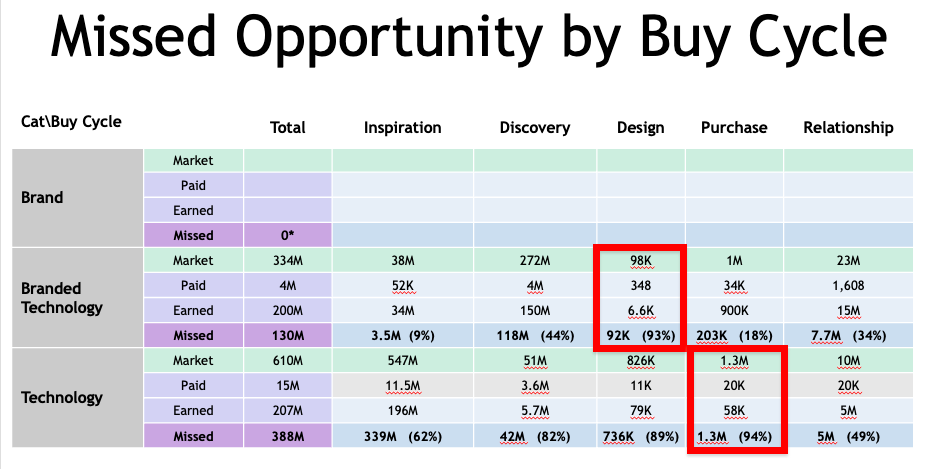For the past 30 years I have worked at the enterprise level of digital and search marketing. Working for big companies, you need to be creative to get buy-in and advance your projects and ideas, requiring me to develop several “creative reports” to generate executive attention. The following are various models that will hopefully help you make your case of the strategic value of Search Marketing.
Opportunity Realized – No BS Report
One of my favorite reports, and the first we built into DataPrizm back in the day, was the No Bullshit Report that, for politically correct reasons, we renamed the Opportunity Realized Report. This report took the missed opportunity Matrix above and then demonstrated how much of that opportunity we have captured. The mandate for this report came from a client whose boss wanted to use his friend’s digital agency. Using this report, we could demonstrate how much of the projected traffic, IF the SEO recommendations were implemented, was captured.
A straightforward report, the orange was the stats at the start of the project. The white is what we predicted. If we can make the changes, we could capture 3 to 5% of the missed opportunity. The green section was the current performance, and the blue realized the number of added visits and the share we predicted. We showed increases, decreases, and no change, as this is the reality of what we were generating. This pushed the team to think of performance and activities that would contribute to capturing what was expected as they worked on the project. The revenue contribution section below the matrix shows the volume of revenue derived from the incremental.

Demonstrate the Cost of Inaction
We built this report one day after getting pushback to our NO BS Report, where a manager was frustrated we had not delivered the revenue and traffic we had predicted in our models. The problem was his team was not implementing any of the recommendations. We created a worksheet and estimated the traffic improvement for the various tasks. We then used an @now command to calculate the number of task backlog days and multiplied it against the traffic for that period. In most cases, the tasks were 3 to 6 months backlog with a few over two years old. By tying task inaction to revenue, we had something we could point to that put the focus on the case of the lack of results. We had an internal code name for this report, ITKMP, which means “IT Killed My Performance” report.

Demonstrate Missed Opportunites – Missed Opportunity Matrix
This is one of the early versions of the Missed Opportunity models we used to motivate brands to make organic search changes based on the volume of opportunities they were missing. We used 3% and 5% as our opportunity share. With this client, their average order was $85. Getting 3% of the search volume for the things they sell would increase revenue from $127k annually to $12.5 million. This is a great motivator,r especially when you can demonstrate why they are not ranking well.

Demonstrate Incremental Costs – Cost of Not Ranking
This is another one of my favorite reports to present to a CMO who was uninterested in SEO, so much so that he said I could leave the global pitch meeting I had flown in to attend. I was allowed to stay, but I was pretty frustrated by his comments. As the meeting progressed he talked about costs and ROI blah, blah, blah. He agreed to give me 15 minutes.
I opened with this slide, showing that he was missing out on “free clicks.” He ONLY needed to make minor changes and adapt a few elements to get this traffic. In his case, he must buy that traffic because they have no representation in search. To get a simple 5% of the search volume that he should get from organic would cost him $2.6 million a month or more than $31 million a year. This caught his attention. He had never considered the cost of buying the clicks that he could get for free. We explained he can continue to spend that, but what if we can spend $100k to offset even a fraction of that cost?

Demonstrate Revenue Contribution
The screen below was a model we created with a client to show the revenue contribution of organic search.

Demonstrate Revenue Potential
The screen capture below was used to convince management that there was both awareness and revenue value to a cocktail website. Management would shut it down because it was not delivering traffic or unique value. The site had potential if we gave it some attention. I created this small application that I called the “Cocktails to Bottles” model. Using the same illusionary methods as other “faith-based marketing” tactics like TV and print, we simply wanted some sort of cause-and-effect data point that could encourage management to reconsider.
We combined data from organic search visits, the ratio of “viewed to made it” clicks in our app, and the amount of alcohol in each drink to demonstrate that the more people who look at the recipe that uses our spirit, the more bottles we could sell. It was a bit cheez,y but it did work to both get a reprieve for the site and plant the see that there is a correlation between people looking for drinks and needing the alcohol required.
Ultimately, it worked, and the site drove millions of visits each month, with numerous digital and search awards, including being the first Search-related entry for a Cannes Lion.

Motivating Change
This is another chart presented in a C-Suite meeting where we tried to motivate department managers to engage in Search. Despite a global mandate, not all were engaging. This chart reflects the performance of business units. The one on the far right caught the attention of the CEO, who asked, “Where is the green?” resulting in this being called the “Getting Green Report,” with a similar version for revenue.

Missed Opportunity Insights
We had been asked to expand the Missed Opportunity Models to identify insights across buy cycles, product categories, and audience types. We mined over 10 million search queries assigning them to the categories and integrated paid and organic data specific rank and click data. We identified significant gaps in both paid and organic across all phases of their buy cycle.
The company had a significant initiative to map and capture across the customer journey. We identified 90+ percent gaps in the design phases (selecting technology packages) and the purchase phase, which is critical for sales. This set the stage for a two-year project to capture this gap, estimated at over $100 million. That revenue potential identified Search as a strategic driver of revenue thus elevating it across the board as a mission-critical activity.

Strategic Insight Challenges
One of the challenges I never anticipated as I tried to use data to tell stories and motivate action was how different constituents might react to the data, in the example of the site search mining exercise that elected several responses. It was interesting to see the negative pushback from the opportunity by those who would need to do extra work and those who may have some revenue cannibalization.
Senior Management – They saw this an a revenue opportunity and wanted to know how quickly can we generate new or modify content to capture this potential revenue.
Content Team – They were panicking and overwhelmed at how much content would need to be created or adapted and how they would do it. There was also concern from the manager that they might be criticized for not detecting this merchandising opportunity.
Onsite Teams – The onsite team was concerned this might impact revenue generated at the location by minimizing upsells. The manager said they can often upsell customers, which may decrease if they prebuy, affecting their performance.

